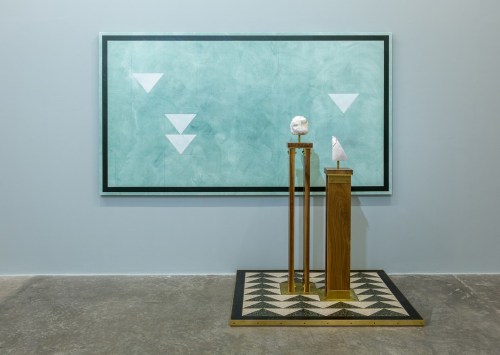
Installation view of Kamrooz Aram, A Monument for Living in Defeat, 2016, mixed media, dimensions variable.
Interview with Kamrooz Aram
By Michael Stipe
January 3, 2017
Kamrooz Aram is a Brooklyn-based artist whose works often challenge a modernist disdain for decoration, ornamentation, and patterning. His current solo exhibition, which is on view at the Green Art Gallery in Dubai through January 8, 2017, features new sculptural installations wherein paintings are explored as mere decoration. Positioned as backdrops to tableaux that might recall museum displays of ancient art, the vibrant, buzzing canvases in these works appear both passive and active. Aram will also have a solo exhibition at the Museum Dhondt-Dhaenens in Deurle, Belgium, from February 5 through April 4, 2017. Here, he discusses his presentational strategies for both shows.
I TEND TO EMBRACE some of the more taboo subjects in art. For instance, making something that’s emotional, or that has a spiritual presence—these are things that are difficult to talk about because they’re dismissed, by academia mostly, as things that lead to subjectivity and sentimentalism. But not all emotions lead to sentimentality, and not all definitions of spirituality have to do with subjectivity.
The collages that I’m showing at Museum Dhondt-Dhaenens are simply pages from midcentury books that document ancient Persian art. The pages are adhered to linen with minimal pencil lines and monochromatic painting; essentially I’m recontextualizing found images. I’ve realized that so much of my process is formal. When I’m composing a painting or when I’m choosing an image for a collage, it really is an intuitive and formal process.
These collages will be shown alongside sculptural works that present ambiguous objects in museum-like displays. Some of the objects appear to be genuine antiquities, while others may have been made by myself in the studio, and yet others may have been acquired at a museum gift shop. I’m interested in highlighting the importance of exhibition design in shaping one’s understanding of objects in an encyclopedic museum. There is always an interdependence between the object, the pedestal, and the painting. The pedestals in these works use materials such as brass, hardwood planks, and terrazzo—looking at the work of architects such as Carlo Scarpa inspired these choices.
In the Correr Museum in Venice, which Scarpa renovated from 1952 to 1953, there is a room in which paintings are set into large slabs of travertine. If you look closely, you can see evidence of the pencil lines indicating where the travertine should be cut, and the lines extend just a bit off the corner. It’s this really beautiful, human moment where the craftsman’s functional mark becomes a sort of expressive mark. In a previous series of paintings I referenced graffiti cover-up, which is also a form of labor that resembles artmaking. People are sent out to cover graffiti, and they are just painting however they paint “naturally”—the process is automatic and uninhibited. What results are apparently banal or bored marks. But I’d argue that there’s some care in it. When you look closely, you might see how the worker was a precisionist, though most of the work is imperfect. Despite his fanatic attention to detail, there are moments of looseness in Scarpa’s work, too—the pencil lines on the travertine, for instance; he never went back to erase them.
The idea of the painting as a backdrop to an interior is something that I’m interested in. There’s an analogy to music—sometimes you’re actively listening: The music is on, you’re totally present, following the lyrics, there’s no distraction, there’s nothing else. But other times, perhaps most of the time, you might be in a car or a café and a song is on, and you’re talking with someone, and that song somehow affects your mood, and affects your conversation, but in a way that you can’t quite say. Perhaps it happens at the subconscious level. The music is a backdrop. The idea of painting as backdrop is present in my titles—a previous exhibition was titled “Unstable Paintings for Anxious Interiors,” and my upcoming museum exhibition in Belgium will be titled “Ornament for Indifferent Architecture.” The latter is a response to Luis Barragán, who said that all architecture should be emotional architecture—though often it’s not. This idea made me think about how art functions as an element of architecture; it becomes part of the architecture and has the potential to enhance it. I think painting—and art in general—can help indifferent or banal architecture become emotional architecture.
— As told to Michael Stipe